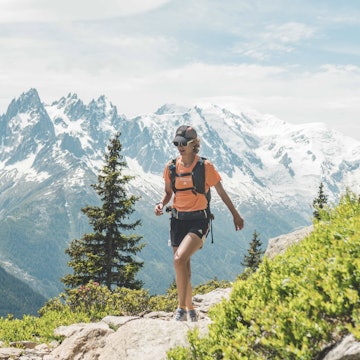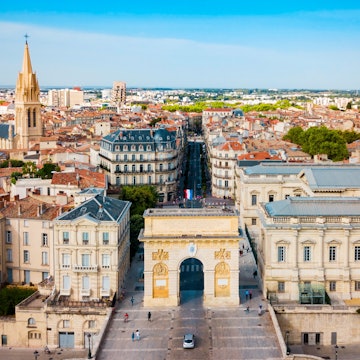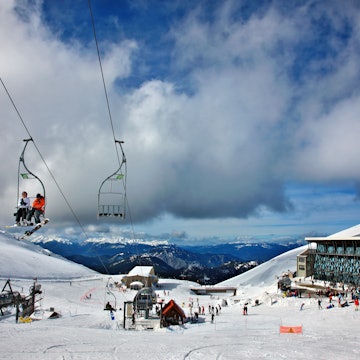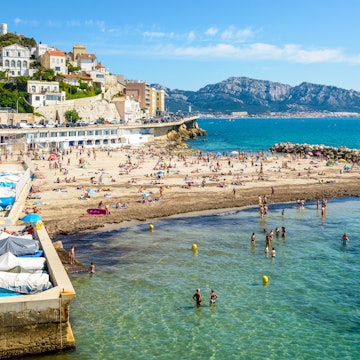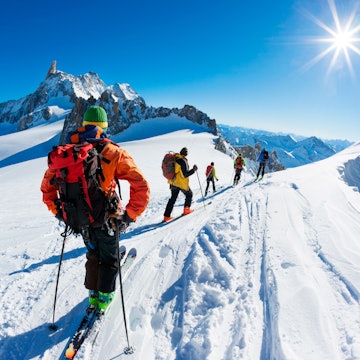
The best outdoor activities in France (and the best places to try them)
Aug 18, 2022 • 9 min read
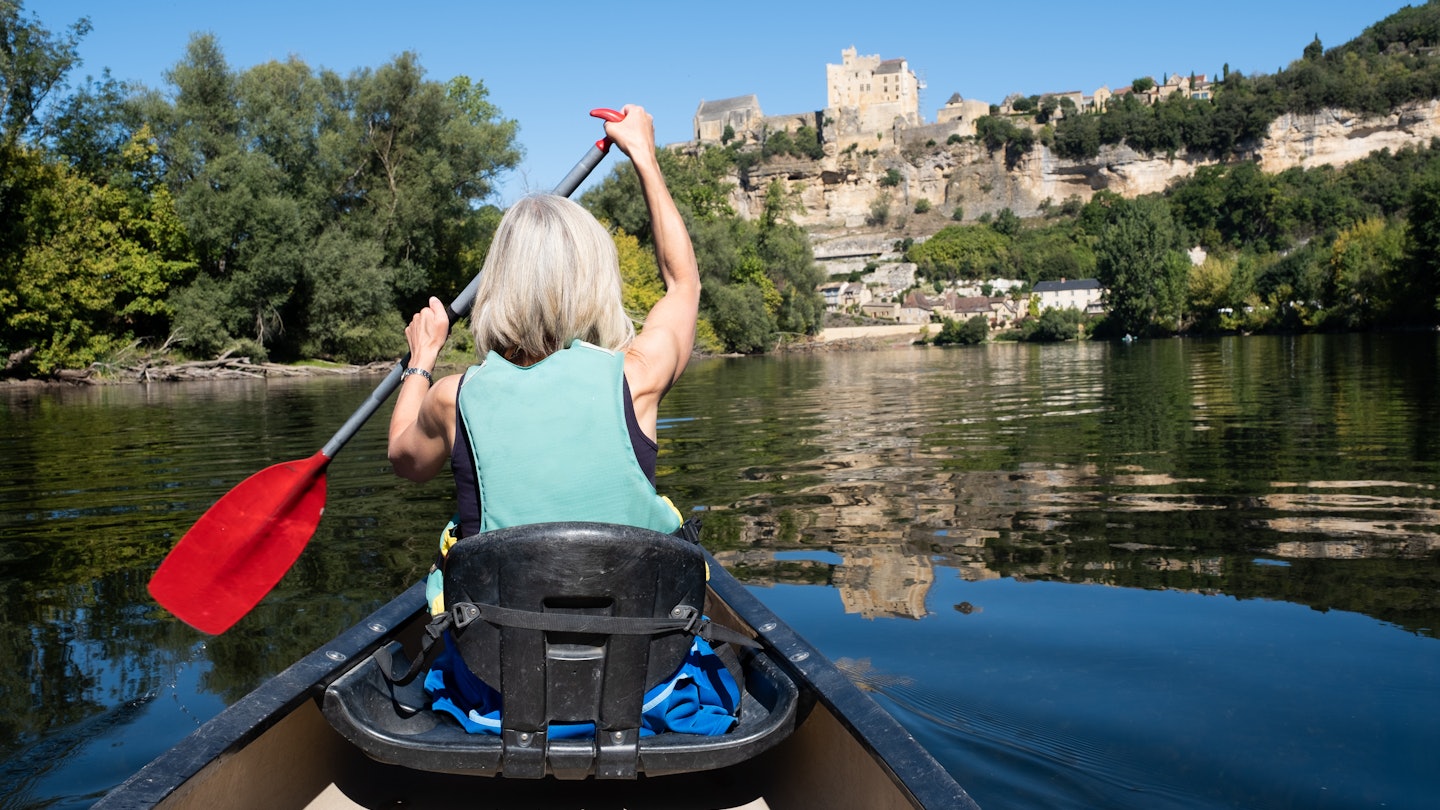
France offers adventures aplenty, from epic hikes to gentle paddles on scenic rivers © lucentius / Getty Images
Mighty mountains, wild rivers, green hills, Alpine valleys – the astonishing diversity of the French landscape is one of the country's biggest draws, but there’s more to a visit to France than just sitting back and admiring the view.
There are myriad ways to get outside and active in les grands espaces (the great outdoors), from ever-popular adventure activities such as hiking and cycling to more esoteric options such as paragliding, scuba diving and via ferrata (scrambling, clipped to a metal cable). All that’s required for the following French thrills is a sense of adventure.
Hike shepherds’ paths in the French Pyrenees – like the Alps, minus the crowds
There’s no end to the places where you can enjoy a hike in France, but few spots can offer the big vistas (and views) of the French Pyrenees. Less crowded than France’s other great mountain range – the mighty Alps – the Pyrenees region offers a wealth of incredible hikes, traversing pretty valleys, mountain meadows and lofty peaks. Many of these trails have been followed by Pyrenean shepherds for centuries, and you might well spot some of them herding flocks of sheep and goats, especially during the twice-yearly transhumance (when livestock is moved to and from the summer pastures).
For serious hikers, the long-distance GR10 and GR11 offer formidable challenges, as does the Haute Randonnée Pyrénéenne, an epic long-haul trail that traverses almost the entire length of the Pyrenees from Spain to France. For shorter routes, try the hikes to the Cirque de Gavarnie, Lac de Gaube, Mont Né or Pic du Canigou.
If you prefer your trails to be crowd-free, consider walking in the Cévennes, the range of forested hills and plateaux to the north of Montpellier, in Languedoc-Roussillon. The mountains of Corsica are also fantastic for escaping the crowds – the ultimate challenge here is the GR20, the 180km (112-mile) route that runs right down the island’s rocky spine. It’s not a hike for the unfit or the faint of heart, but for sheer cachet, nothing else compares.
Cycle along the banks of the Loire, France’s longest river
Flowing across France for 1020km (634 miles), the Loire is the country’s most majestic waterway. It’s most famous for the many lavish châteaux that line its banks, constructed by French kings, queens and aristocrats, but it’s also a brilliant place to explore by bike. A dedicated network of cycle paths (collectively known as La Loire à Vélo) has been developed, carving up the glorious Loire countryside into short, manageable sections that are achievable even for novice cyclists (the Loire valley is mercifully flat).
Much of the route runs along the banks of the Loire, offering wonderful views over the river, and it’s easy to find accommodation in the many small towns and villages along the route. There are also plenty of little cafes and bistros where you can fuel up for the journey.
Many other similar routes are scattered around France. The Canal des 2 Mers en Vélo cycling route runs from the Atlantic Coast to the Mediterranean via a chain of inland canals, while the 236km (147-mile) Autour du Luberon route runs through the dreamy countryside of central Provence.

Hit the slopes in Chamonix, the home of French skiing
If you’re a snowhound, you’ll already be familiar with the hallowed names of the top skiing destinations in the French Alps. The slopes at Courchevel, Méribel and Val d’Isère are legendary amongst skiers and snowboarders, and all have played a huge role in developing winter sports as we know them today.
But for Alpine fame, nowhere measures up to the mountain town of Chamonix. Tucked in under the formidable bulk of France’s highest mountain, 4808m (15,774ft) Mont Blanc, it’s surrounded by some of the best skiing in all of France, from pristine groomed runs to hair-raising off-piste routes that are only suitable for seriously experienced skiers and snowboarders.
Most esteemed of all is La Vallée Blanche (The White Valley), a 2.8km (1.7-mile) off-piste route that is considered to be one of the most challenging and thrilling slopes on the planet (it even featured in a James Bond movie). Only the very best skiers can hope to tackle it, and you’ll need an experienced guide, but it’s a once-in-a-lifetime achievement.
Catch a (surf) break on the French Atlantic Coast
Some of Europe’s highest waves roll in from the Atlantic and smash into the west coast of Spain, Portugal and France – making these areas hugely popular with surfers. Surf central in France is the Atlantic town of Biarritz and the stretch of coast that stretches up to Hossegor – it's southwest France’s answer to the Californian shoreline.
Numerous surf lodges and surf camps offer somewhere comfy to sleep after a day on the waves, alongside tuition and tips for novice and experienced surfers alike. There are also plenty of places where you can hire a board if you haven’t got the baggage room to bring your own.

Paddle down the Dordogne past châteaux and cave paintings
There are few better ways to see France than with a paddle in your hand – and with no shortage of lovely rivers to explore, you certainly won’t have any trouble finding somewhere to do it. Perhaps the prettiest of all is the Dordogne, the river that snakes for 483km (300 miles) through the limestone hills of southwest France.
This area has been inhabited since prehistoric times, and the Dordogne is littered with some of Europe’s oldest cave paintings (many of which are found in the deep caverns around the Vézère Valley), as well as some impressive castles, gardens and medieval market towns.
But it’s the gloriously green countryside that steals the show, and drifting along the Dordogne in a canoe is perhaps the most enjoyable way to experience it. The route between Argentat, Beaulieu-sur-Dorgdogne, Veyrac and Souillac is dotted with canoe companies who can help you get out on the water, either solo or on a guided group trip.
The Ardèche in southeastern France is another super river for paddlers, particularly the stretch through the craggy Gorges de l’Ardèche.

Go whitewater rafting in the Gorges du Verdon, Europe’s mightiest canyon
If you’re after a little more adrenalin on the water, how about clambering into an inflatable boat and heading out into a foaming mass of whitewater rapids? Several French rivers offer white-knuckle rafting trips, in which you and a group of fellow rafters will find yourself plunged into a wild rollercoaster of water armed with nothing more than a flimsy plastic paddle and a prayer.
The best rapids are found around canyons and gorges such the Gorges de l’Ardèche and Gorges du Tarn, but for the maximum endorphin rush, the epic Gorges du Verdon – the largest canyon in Europe – takes top prize. Be warned: it’s a wild ride and you’re 100% guaranteed to get a soaking. The town of Castellane is the main hub, with various routes nearby, including the memorable trip to appropriately-named Point Sublime.
Kayak the Calanques to discover secret beaches
Finding space on the beaches of the French Riviera in summer can be next to impossible, but there is a corner of France’s Mediterranean coast that’s usually much less crowded, and that’s the Calanques – the web of high-walled inlets that pockmark the parched white cliffs to the south of Marseille.
Celebrated for their brilliantly blue water, these hidden channels offer brilliant swimming and secluded sunbathing, but the trek down to them can be exhausting in the heat of summer. A much better way to reach them is by sea – local kayak companies run guided trips to many of the inlets, with the added benefit that whenever you get too hot, you can just slip into the sea for a refreshing dip.

Paraglide past the ancient volcano of Puy de Dôme
The Auvergne is a little-known corner of France, but it’s a place of great beauty – and home to a peculiar landscape of extinct volcanoes known as puys. These rumpled humps are one of the best places in France to paraglide – sailing the invisible updrafts thrown up by the landscape attached to a parachute.
It takes considerable skill to master the art of paragliding, but local activity providers offer tandem trips where all you have to do is sit back and take in the incredible views. The imposing Puy de Dôme is the classic paragliding location, and if the weather is right, you’ll see plenty of paragliders soaring silently around the summit.
Scuba dive in the Réserve Naturale de Scandola
Corsica is an incredible spot to learn to dive. Surrounded on all sides by sea, the Île de Beauté has some of the most pristine waters anywhere in France, including the glorious Réserve Naturelle de Scandola, a protected area that covers more than a thousand hectares of the Mediterranean off the island’s west coast, near Piana.
It’s not possible to get into the reserve on foot, so traveling by sea is the only option – sightseeing trips can be arranged, but to really appreciate the reserve, you need to get into the water, either by snorkeling on the surface or, better still, by strapping on a scuba tank. Colorful coral, moray eels, groupers, octopi, swordfish, tuna and sea urchins are just some of the creatures you might spot here.
Another great location for snorkellers is the Îles d’Hyères – a small archipelago of islands south of Toulon, which includes the national park of Port-Cros. The islands’ beaches and rocky coastline are brilliant for exploring with flippers and fins.

Challenge yourself on a via ferrata – it’s rock climbing, but not as you know it
First developed by Italian troops during WWII, the via ferrata (‘iron way’) enables even novice climbers to ascend the heights for jaw-dropping views. Using a system of fixed cables, ladders and bridges, you’ll find yourself traversing sheer cliffs, steep summits and jelly-leg-inducing drops that would otherwise only be accessible to experienced climbers.
It’s extremely safe and fantastic fun, but you will need to bring your own head for heights. There are via ferrata routes located all over France, especially in the Alps. Standout locations include La Via des Evettes and the Mer de Glace near Chamonix, Rocher de la Chaux near Morzine, and the Grande Fistoire near Sisteron.
If you can’t make it to the mountains, don’t fret – you can hone your climbing skills without leaving the capital. The sandstone escarpments of the Forêt de Fontainebleau, on the edge of Paris, are a popular area for bouldering – many top French climbers come here to practice before hitting the big walls.








